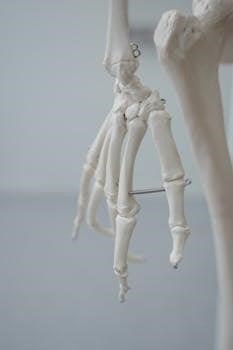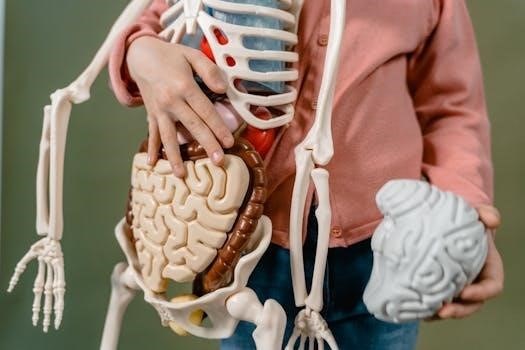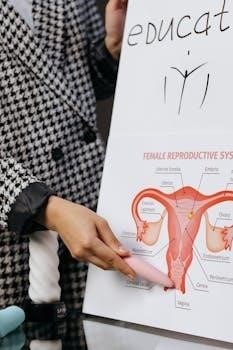Essentials of Human Anatomy and Physiology PDF
Essentials of Human Anatomy & Physiology is designed to help you focus on the core concepts. This resource combines accessible text with easy-to-follow figures. This provides the essential content needed to succeed in a one-semester A&P course. This offers a balanced approach for students.
Anatomy and physiology are fundamental sciences that explore the structure and function of the human body. Anatomy examines the body’s physical components, from macroscopic structures visible to the naked eye to microscopic details requiring specialized tools. Dissection is a traditional method, while modern imaging techniques offer non-invasive insights.
Physiology, on the other hand, investigates how these structures function, both individually and in coordination, to maintain life. It delves into the chemical and physical processes that underpin bodily functions, revealing how organs and systems work together to sustain life. The study is essential for healthcare professionals and anyone interested in understanding the body’s intricate workings.
Understanding anatomy and physiology provides a foundation for comprehending disease processes and making informed health decisions. This knowledge is invaluable for anyone pursuing a career in healthcare, offering insights into the body’s normal functions and how they are disrupted by illness. These insights are essential for effective diagnosis, treatment, and prevention of disease.
Levels of Structural Organization
The human body is a marvel of hierarchical organization, exhibiting distinct levels that build upon one another. At the most basic level are chemical components, including atoms and molecules. These molecules combine to form organelles, specialized structures within cells that carry out specific functions; Cells, the fundamental units of life, are formed from organelles.
Similar cells with a common function group together to form tissues, such as epithelial, connective, muscle, and nervous tissue. Different tissues then combine to create organs, which are discrete structures performing specific tasks. For example, the heart, composed of muscle, connective, and nervous tissues, pumps blood throughout the body.

Organs that work closely together to accomplish a common purpose form organ systems. The cardiovascular system, comprising the heart, blood vessels, and blood, transports nutrients and oxygen throughout the body. Finally, all organ systems work in concert to form the organism, the complete human being. This intricate hierarchy ensures that all bodily functions are coordinated and maintained.
Basic Chemistry and Its Role in the Human Body

Chemistry forms the bedrock of human anatomy and physiology, governing all biological processes. At the atomic level, elements like carbon, hydrogen, oxygen, and nitrogen are essential building blocks. These elements combine to form molecules, including water, carbohydrates, lipids, proteins, and nucleic acids, each with unique roles in the body.

Water, the most abundant molecule, acts as a solvent, facilitates chemical reactions, and regulates temperature. Carbohydrates provide energy, while lipids store energy and form cell membranes. Proteins, the workhorses of the cell, catalyze reactions, transport molecules, and provide structure. Nucleic acids, DNA and RNA, store and transmit genetic information.
Chemical reactions, such as metabolism and respiration, are crucial for energy production and maintaining homeostasis. Enzymes, protein catalysts, accelerate these reactions. pH balance, the concentration of hydrogen ions, is also vital, as deviations can disrupt cellular functions. Understanding basic chemistry is essential for comprehending the intricate workings of the human body.
Cellular Structure and Function
The cell, the fundamental unit of life, exhibits a complex structure intricately linked to its function. Enclosed by the plasma membrane, a selective barrier, the cell maintains its internal environment. The cytoplasm houses organelles, each with specialized roles. The nucleus, the control center, contains DNA, directing protein synthesis and cell division.
Ribosomes, either free or attached to the endoplasmic reticulum (ER), synthesize proteins. The ER, a network of membranes, assists in protein folding and lipid synthesis. The Golgi apparatus processes and packages proteins for secretion or use within the cell. Mitochondria, the powerhouses, generate energy through cellular respiration. Lysosomes, containing enzymes, break down cellular waste.
Cellular functions include nutrient uptake, waste elimination, and communication. Membrane transport mechanisms, such as diffusion and active transport, regulate molecule movement. Cell signaling pathways enable cells to respond to stimuli. Cell division, mitosis and meiosis, is essential for growth and reproduction. Understanding cellular structure and function is crucial for comprehending tissue organization and organ physiology.
Tissue Types and Their Functions
Tissues, the building blocks of organs, are collections of similar cells performing specific functions. There are four primary tissue types⁚ epithelial, connective, muscle, and nervous. Epithelial tissue covers surfaces, providing protection, absorption, and secretion. Connective tissue supports, connects, and separates different tissues and organs. Muscle tissue is responsible for movement, and nervous tissue facilitates communication.
Epithelial tissues can be simple or stratified, squamous, cuboidal, or columnar, based on cell shape and layer arrangement. Connective tissues include cartilage, bone, blood, and adipose tissue, each with unique functions. Muscle tissues are skeletal, smooth, or cardiac, enabling voluntary and involuntary movements. Nervous tissue consists of neurons and glial cells, transmitting and supporting nerve impulses.
Each tissue type plays a critical role in maintaining homeostasis and overall body function. Epithelial tissues protect against pathogens and regulate transport. Connective tissues provide structural support and immune defense. Muscle tissues enable movement and heat generation. Nervous tissues coordinate body activities. Understanding tissue types is essential for comprehending organ structure and system physiology.
Integumentary System (Skin and Body Membranes)
The integumentary system, encompassing the skin, hair, and nails, serves as the body’s outermost protective layer. The skin, composed of the epidermis and dermis, provides a barrier against pathogens, UV radiation, and dehydration. The epidermis, the superficial layer, consists of stratified squamous epithelium. The dermis, the deeper layer, contains connective tissue, blood vessels, and nerve endings.
Accessory structures such as hair follicles, sweat glands, and sebaceous glands contribute to thermoregulation, sensation, and protection. Sweat glands help regulate body temperature through perspiration, while sebaceous glands secrete sebum, lubricating the skin and hair. Sensory receptors in the skin detect touch, pressure, temperature, and pain, enabling interaction with the environment.
Body membranes, including mucous, serous, and synovial membranes, line body cavities and organs, providing lubrication and protection. Mucous membranes line cavities open to the exterior, secreting mucus for protection and lubrication. Serous membranes line closed body cavities, reducing friction between organs. Synovial membranes line joint cavities, secreting synovial fluid for lubrication and nutrient supply.
Skeletal System⁚ Bones and Cartilages
The skeletal system provides structural support, protection, and movement facilitation for the body. Bones, the primary components, are composed of osseous tissue, cartilage, and marrow. Cartilage provides flexibility and cushioning in joints. The skeletal system is divided into the axial skeleton (skull, vertebral column, rib cage) and the appendicular skeleton (limbs, girdles).
Bones perform various functions, including support, protection, movement, mineral storage, and blood cell formation. They protect vital organs, such as the brain (skull), heart, and lungs (rib cage). Joints, formed where bones articulate, enable movement through muscle action. Bones store minerals like calcium and phosphate, essential for various physiological processes.
Cartilages, including hyaline, elastic, and fibrocartilage, provide support and flexibility in different body regions. Hyaline cartilage covers articulating surfaces, reducing friction and absorbing shock. Elastic cartilage provides flexibility in structures like the ear and epiglottis. Fibrocartilage provides strength and shock absorption in intervertebral discs and menisci. Bone and cartilage work together to provide structure.
Muscular System⁚ Types and Functions of Muscles
The muscular system enables movement, maintains posture, and generates heat through muscle contractions. There are three types of muscle tissue⁚ skeletal, smooth, and cardiac. Skeletal muscle is voluntary, attached to bones, and responsible for body movements. Smooth muscle is involuntary, found in the walls of internal organs, and controls functions like digestion and blood vessel diameter. Cardiac muscle is involuntary, found in the heart, and pumps blood throughout the body.
Skeletal muscles contract to produce movement. Muscles work in pairs, with one muscle contracting (agonist) and the other relaxing (antagonist). Muscle contractions can be isotonic (muscle length changes) or isometric (muscle length remains constant). Muscle contraction requires energy in the form of ATP, which is generated through cellular respiration.
Smooth muscle controls involuntary functions like peristalsis, blood vessel constriction, and bladder emptying. Cardiac muscle contracts rhythmically to pump blood, regulated by the autonomic nervous system and hormones. Each muscle type has unique structural and functional characteristics adapted to its specific role in the body. The coordinated action of these muscles ensures proper body function.
Nervous System⁚ Brain, Spinal Cord, and Nerves
The nervous system is the body’s control center, responsible for communication and coordination. It consists of the brain, spinal cord, and nerves. The brain is the central processing unit, controlling thoughts, emotions, and actions. The spinal cord relays signals between the brain and the rest of the body. Nerves transmit signals to and from the central nervous system.
The brain is divided into several regions, each with specific functions. The cerebrum controls higher-level functions like reasoning and memory. The cerebellum coordinates movement and balance. The brainstem regulates vital functions like breathing and heart rate. The spinal cord is a long, cylindrical structure extending from the brainstem. It transmits sensory information to the brain and motor commands to the muscles.
Nerves are bundles of fibers that transmit electrical and chemical signals. Sensory nerves carry information from the body to the central nervous system. Motor nerves carry commands from the central nervous system to the muscles and glands. The nervous system enables rapid communication and precise control, essential for maintaining homeostasis and responding to stimuli.
Special Senses⁚ Vision, Hearing, Taste, Smell, and Equilibrium
The special senses provide crucial information about the environment, enabling us to navigate and interact effectively. Vision relies on the eyes, which detect light and convert it into signals the brain interprets as images. Hearing involves the ears, which capture sound waves and transform them into electrical impulses perceived as sound. Taste buds on the tongue detect different flavors, contributing to our enjoyment of food.

Smell receptors in the nasal cavity identify odors, triggering memories and influencing behavior. Equilibrium, or balance, depends on the inner ear, which senses head position and movement, helping us maintain stability. Each special sense involves specialized receptors and neural pathways that transmit information to specific brain regions for processing.
These senses are vital for survival, allowing us to detect danger, find food, and communicate with others. Visual impairments, hearing loss, taste disorders, olfactory dysfunction, and balance problems can significantly impact quality of life. Understanding the anatomy and physiology of the special senses is essential for diagnosing and treating related conditions.
Cardiovascular System⁚ Heart and Blood Vessels
The cardiovascular system, consisting of the heart and blood vessels, is essential for transporting oxygen, nutrients, hormones, and waste products throughout the body. The heart, a muscular organ, pumps blood through a network of arteries, veins, and capillaries. Arteries carry oxygenated blood away from the heart, while veins return deoxygenated blood to the heart. Capillaries facilitate the exchange of substances between blood and tissues.
The heart has four chambers⁚ two atria and two ventricles. The atria receive blood, and the ventricles pump blood out. Valves within the heart ensure unidirectional blood flow. The cardiac cycle involves alternating periods of contraction (systole) and relaxation (diastole). Blood pressure, the force exerted by blood against arterial walls, is a crucial indicator of cardiovascular health.
The cardiovascular system is regulated by neural and hormonal mechanisms to maintain homeostasis. Disorders such as hypertension, atherosclerosis, and heart failure can impair cardiovascular function. Understanding the anatomy and physiology of the cardiovascular system is essential for preventing and treating cardiovascular diseases, which are a leading cause of mortality worldwide.
Homeostasis and Disease
Homeostasis is the body’s ability to maintain a stable internal environment despite external changes. This dynamic equilibrium is crucial for cell function and survival. The body achieves homeostasis through feedback mechanisms involving receptors, control centers, and effectors. Negative feedback loops counteract changes, while positive feedback loops amplify them.
Disease occurs when homeostasis is disrupted, leading to abnormal physiological function. Pathogens, genetic mutations, and environmental factors can cause disease; Understanding the mechanisms of disease requires knowledge of anatomy, physiology, and pathology. Diagnostic tests and medical interventions aim to restore homeostasis and alleviate symptoms.
Maintaining homeostasis is essential for preventing disease and promoting health. Lifestyle factors such as diet, exercise, and stress management play a crucial role in supporting homeostatic mechanisms. Chronic diseases, such as diabetes and hypertension, often result from prolonged disruptions in homeostasis; By understanding the principles of homeostasis, we can develop strategies to prevent and manage disease, ultimately improving overall health and well-being.